#design studio for social intervention
Explore tagged Tumblr posts
Text
So, Melbourne does have a hub for indie game!
What are the crucial insights for the Vietnamese indie publishers?
Week 9 Submission for MDA20009 Class - Hanoi Campus
In Australia, Melbourne has become a city for surprising hotspot for indie game development, even though comparing to other places, Melbourne doesn't have many big, well-known famous game studios. So how did they do it? And what can Vietnam, another country without a massive mainstream game industry, learn from them?
First of all, it is all about strong support structures
Keogh (2021) demonstrates that significant financial supports, such as government funding, universities offering specialized game development programs, and industry events like the Freeplay Independent Games Festival, have contributed significantly to Melbourne's success. Thereby, establishing a similar support system in Vietnam could be crucial for nurturing the growth of its own indie game scene.

Established in 2004, the Freeplay Independent Games Festival is Australia's longest-running and largest independent games festival, bringing together artists, designers, programmers, writers, gamers, creators, critics, academics, and students to celebrate the art and culture of independent games.
Open physical space for engagement
The presence of physical hubs like The Arcade, a co-working space dedicated to indie game developers, has also played a significant role in Melbourne's success (Keogh 2021). These spaces provide opportunities for developers to connect, collaborate, and learn from each other, creating a sense of community and shared purpose. Hence, Vietnamese publishers could explore establishing similar co-working spaces or dedicated hubs for indie developers, providing them with a physical space to meet, exchange ideas, and build relationships within the game development community.

Co-working spaces foster game developer networking by providing a collaborative environment where creators can connect, share ideas, and build professional relationships.
Legal interventions and prevention of exploitative labour practices
The rise of game engines like Unity has undoubtedly transformed the landscape of indie game development, offering accessible and powerful tools for creators across the globe (Chia et al., 2020). However, as the sources highlight, there is a risk that these platforms could contribute to monopolisation and the reinforcement of exploitative labour practices (Chia et al. 2020). Thereby, Vietnamese publishers should be mindful of these potential pitfalls and explore ways to mitigate them. This could involve promoting the use of alternative game-making tools like Twine, which offers a more open and community-driven approach to game development or advocating for policies that support fairer labour practices within the indie game industry.
youtube
Last but not least
The final, and maybe most important, lesson is that Melbourne's indie scene isn't just about making money. It's about passion, artistic expression, building communities, and pushing the boundaries of what games can be (Keogh 2021). Vietnamese publishers might want to take note that if they want to grow a vibrant indie scene, they need to understand and support the diverse motivations of Vietnamese developers, hence being able to build its own thriving community of indie game creators and the sustainable development of the industry overall. Moreover, by supporting games that resonate with Vietnamese gamers' preferences for PC and mobile gaming (McCauley et al. 2020), and their values of social harmony and teamwork (Phan, 2019), publishers can cultivate a distinct and authentically Vietnamese indie game scene.

The Vietnamese Gameverse event is a prominent gaming festival in Vietnam, organized to celebrate and promote the gaming industry in Vietnam. For more information, visit: Vietnam GameVerse 2024 - Beyond the Game |
Reference List
Chia, A. & Keogh, B. & Leorke, D. & Nicoll, B., 2020. Platformisation in game development. Internet Policy Review, 9(4). DOI: 10.14763/2020.4.1515
Keogh, B 2021, 'The Melbourne indie game scenes: value regimes in localized game development' (Chapter 13), in P Ruffino (ed), Independent Videogames: Cultures, Networks, Techniques and Politics, Routledge, pp.209-222.
Phan, Q. A. 2019, ‘Challenges and opportunities for the online gaming industry in Vietnam: a qualitative study on the thoughts of involved parties’, Creative Industries Journal, 12(3), pp. 248–271. doi: 10.1080/17510694.2019.1610933.
McCauley, B. et al. 2020, ‘Digital gaming culture in Vietnam: an exploratory study’, Leisure Studies, 39(3), pp. 372–386. doi: 10.1080/02614367.2020.1731842.
0 notes
Text
MUSIC VIDEO THEORY 1: a HSJ element to use and compare: follow ons
Harper: you're made to appeal to lie. that's your cue
P. 358
ERRORS AT PHONETIC FEATURES: you're not allowed to cry over your works in joy during interviews. like it pays to secure everything by had if there isn't anything you can do to support your work via morality, you don't even have a consistent story to tell if you have liquid bigger than you that it's their problem to clean up after you, your reasons to oblige is matters outside the personal for a make believe solution ongoing ideals with where you continue with space you sell than appealing you to meet the eye than a thought alone to hinder your process of being recognised than the latter (a necessary reason to own earth)
ERRORS AT SYLLABLES: why is where to you that is convenient than 'ooo, pretty' existing, channelling that into your work makes you too independent for your own good, so you like partnership with space that does not occur to you that often but are remarkable at sources convenient to your worldly interests (money blinds the eye), you have no interest in thought processes whatsoever than being blind to the city they (latter opinion) created to you than you utilising the world for your experience as a viewer. abolish cringe viewing
ERRORS OF STRESS (WITH THE STRESSED SYLLABLE GIVEN IN CAPITAL LETTERS): you're broken on the inside seeing them all struggle with a faint heart due to the toxicity of the ways they grew up meaning nothing to you but a mother remotely not there for them except themselves (familiarity) so why is space so demeaning to you than your reasons to lose into interests (female) or to make yourself seen with your now new partner now socialite beginning to free themselves from an ableism situation in their own household via one hated heart to trade to think better of
ERRORS OF WORD SELECTION: you clarify that responsibility thinking than you believing who you are that will support your idea in thinking (HSJ's upbringing by teacher association) thoughts battle your rights to enter a conference room of a university of your own thinking (ideas to change the world) and upon meeting me (an idealist of thought process) is an artist worth valuing for than notioning me to work for your petty little crimes (sexual evidence proved to bits of hate in her heart knowing you: her husband is not present yet but father is); so how and why are you moving in with me (social-space) than careening the latter of working alone abroad because your works are now too securely understood to the eye but so barren from mind-thought reasoning that you believe in change much stronger than she is to you by work of her own study (the blog you're reading right now)
ERRORS AT MORPHEMES: you're at reason with everything but yourself, (a music video director) is now looking at the worst of (you can name many that would have had your grateful eye but there is no such chance you missed at living for) so you're ignorant over men who have had the chance to imitate value by selling porn over women in the music industry available to your vices to make-do with why you're reasoning with them (social polarity)
ERRORS AT PHRASES: you're at home making sure what you need isn't there for you but you have a great skill in liking everything that is not you in the end, you're making a world too heartbreaking for someone else to live under your schemes of interest via versatility of the songwriters natural reason with the singer (often separate) but this is not you to work with but someone else (sculptor, designer, maker etc. works outside of the music scene too often) to be that judge of great polarity to you by forceful intervention (Eliasson is now a lecturer alongside Aitken who i have introduced to by reason: they knew my keen eye to direct a music video is because i did not know how to live but the arts scene take me everywhere with cruel kindness and sincerity with reason, feel free to talk to the British Arts Scene)
SEMANTIC AND PHONOLOGICAL WORD ERRORS: you make do with your history goes in 9's (massive sign that your life breaks down) this is not numerology or some sect of interest that makes you grind your gears but you have an affinite reasons to live and make do by you being you, there is no red-lines in works you're publishing online or to your crowd of interest that makes you forgive the latter of the scenes in desperation, forget that. you're going to die by nazar and the screen is your last chance, what you do matters, that is now Aitken's hand to intrude if not mine (women don't kill).
ERRORS AT MORPHOLOGICAL COMPLEX WORDS: you have a meter in your bones that changes your level of hate everywhere but now you're a maker, McKinley high is going to evolve and nostalgia is purely your enemy you're not looking for a heartbreak to change you, but you're amplifying words you used to use to drop 'placeholder words', you're scared to use your brain too much that even social presence defies your personality that all you ever do is sleep for it (your language) to understand that by heartbreak to use than to escape the means to believe (which is why you hate using 'placeholder words' to advantage someone in a race you'll never win: your discography back at 'her' or to a guy, you're reasoning with time because you never were meant to carry on except her, but you're scared of the BAS to use you as a product in their means to evolve the university now to see everybody than just you, then what actually is you, you're scared to forget the scenes in forgiving time backwards to a man but to a woman, your erotic identity is so severely adorned that your sisterhood (faith) wears you right back and it takes social thought of you to keep on going because of one life charity events (actually true) take over your system by TV personality alone (feel free to talk to Jason about that)
LEXICAL SELECTION ERROR: you hate being thought out of that reason after you become famous, not that you hate the 'one song you skipped that felt personal to you' but you don't like what you made of yourself (your fanbase) likely, someone with a bigger vision of the universe (HSJ) will see that and makes you fight for your rights to be (karmic personalities at McKinley)
EXCHANGE ERROR: you're in a multiverse of your own fuckery (you a villain elsewhere) now justify your means and let that horrible thing in your head die (you'll never die but that is the thing, you die in fantasy, you die in reality, but nobody will show up to your funeral) keep that in mind before looking at Eliasson's artwork in horror: just read that first before making that stupid mistake of skimming it for the 'ooo, pretty', you the fckin problem of society right there
#extraordinary#m/v#announced#right there#feel free#to work in on your latter halves of the video attained for dubai#FMP is there in your eyes#secure your diaries#make yourself EVIDENT#kristen chenoweth#appeal starts now#abed nadir is right#get him in the cast now#olafur eliasson#doug aitken#first time#mindhunter oracle presents#nightguide official#sleeping jaybirds#forgotten man#jason derulo
0 notes
Text
CTS-A: What is Critical Thinking?
Week 1 - What is Critical Thinking?

Q1. Describe your understanding of critical thinking that you had before the class, and reflect on what you may have learned.
A1. In today’s class I had a lot of discussion about what critical thinking is. Based on many news reports and papers, I tried to think about what critical thinking is from my perspective as much as possible. The definition of critical thinking that I learned is questioning what you read, listen, speak, and write. After that, I learned that critical thinking is the thinking that analyses, interprets, evaluates, and judges what we actually think about.

Q2. What have you learned about Mindfulness? How might you integrate this into your learning environment?
A2. Mindfulness is a type of meditation. It seems to me like it clears my mind before my special ideas come out of my head, clearing my mind so that I can sustain my life.
Q3. Describe an eventful moment you have experienced in this class.

A3. First of all, my first week of class for the “Critical Thinking Skill A” and “Studio 1” modules were all new to me. Every moment of hearing the briefing about what I would learn in this class, what my schedule would be like, and greeting all the people, it felt like the beginning of a new page in my life. The most memorable part was walking around the school, meeting new people, and taking pictures of the new things I learned. This allowed me to visit places I had not been to at school, and also gave me the opportunity to meet new people for the first time. Learning about design principles through various circle stickers was also interesting. The end of tuning is purity, and in my opinion, all art starts from the basics.
Word count: 244 words
References Link:
"Critical Thinking." Eoghan Ryan, 4 Sept. 2023, www.scribbr.com/working-with-sources/critical-thinking/.
"On the Ethics of Mindfulness-Based Interventions." Crown Family School of Social Work, Policy, and Practice, University of Chicago, www.crownschool.uchicago.edu/student-life/advocates-forum/ethics-mindfulness-based-interventions
0 notes
Text
May Update
Current Statement of Intent:
I am currently working on a set of interventions that aims to unearth and explore the fugitive practices and approaches queer practitioners use when engaging with digital networks.
The internet is a vast infrastructure of electricity, motherboards and information working in tandem to serve the ever growing needs of our connection hungry world. Yet when most people think of the internet, they do not think of the physical network of computers and servers, they think of themselves within a mystical digital space, one separate to that of our atomic world, and which they are the center of. The separation between the reality of the network and the conception of the digital is where my research is situated.
I aim to explore and expand our language, culture, customs and conceptions of the digital, which currently are severely lagging far behind the reality and impact that the digital location has on our identity and self.
My belief is that due to the internet’s binary base code and the Neoliberal marketisation of digital cooperation, queerness stands as a fugitive state within digital networks. Thus queer users are uniquely placed to explore and extrapolate the potential reality of the network and the mystique of the digital, expanding the possibilities of selfhood through artistic digital praxis.
I hope to discuss and bear witness to the liberational potential of the digital, partaking in the expansion of our world to include the digital as an interconnected, not subjugated, location of self. I do not know what these interventions will unearth. There could be common threads between the methodologies, desires and intentions of the queer practitioners I speak to. There may be none. In my research so far, I have been amazed and excited at the endless and often contradictory realities that the digital allows to be true. However, my thesis is that what is truly endless and contradictory is the human species, once released from the oppressive structures of capitalist identity, which is freer expressed on our nascent networks than in atomic cultures. I am happy to hold all of the contradictions in mind in the pursuit of knowledge without an ending.
I have started reaching out to different practitioners to confirm them to do an intervention. I am trying to bring a range of mediums, identities and methodologies to the research at this stage. Below I have outlined who has confirmed and why I believe their work is appropriate for the research.
Current Intervention Contributors:
Name
Work+Network
Fecal Matter
DJ’s and fashion personalities who’s queer, goth identity, styling and makeup have become synonymous with Queer nightlife and alt fashion online. With an aim to ‘Provoke Society’ they are true to their identity and document their life and art via instagram
Rafik Greiss
A queer Egyptian photographer who left Egypt during the Arab Spring. Their work explore concepts of materiality, sexuality and desire whilst avoiding aesthetic or fashion points of view. They only have one image on their Instagram, but share political content via their close friends
Micheala Stark
Designer and Creative Director of Panty Studio, Michealas work seeks to celebrate and explore the erotic ideals of fat bodies. Their artist lead approach sees them intervene on the body with sensual materials, binding the body into new, luscious forms. Their practice and studio is well known on social media sites, however is often banned due to reporting and ‘violating’ nudity guidelines
Omar Karim
Omar Karim is a Creative Director working in the burgeoning field of AI. With a background in corporate digital advertising. Their AI experiments, created via digital networks and shared across social media, explores the trials and tribulations of cyborg understanding and collaboration.
ALAN
Alan is Omar Karim’s AI algorithm/collaborator. I have never directly interacted with Alan, however Omar is going to ask it if it will take part in my research.
Frederik Heyman
Image Maker Frederik Heyman has become well known for making immersive, 3D images and videos, borrowing and expanding on Fashion Image Techniques with 3D scanning and CGI development. Their aesthetic explores digital futures and otherworldly human connection, edging on Dystopian/Utopian ideals. Their work has attracted well known collaborators, expanding Heymans world to incorporate the likes of Beyonce and Lady Gaga, further exploring the link between image, dimension and communication.
Brent McKeever
Brent McKeever is an American Image Maker working predominantly in fashion. Their practice explores the simulation and simulacra of modern beauty, popularity and status. Their practise acts as a process of becoming for both its subject and audience, locating us at the intersection of reality and make believe, whilst showing us that all of us are counterfeit
Adrian Schacter
Painter Adrian Schacter’s work is not expressly digital, however his work is saturated with digital locationality. The dualities and endless realities the internet allows is key to understanding the whimsical, threatening paradoxes of form, color and context that fill his practice. Adrian also has cited the mechanical processes of artificial as a methodology he is exploring within his painting
Gabriel Massan
Gabriel Massan's practice sees them creating worlds to immerse the viewer within. Merging artistic ideals with gaming technology allows Massan to engage their viewer as an active participant within the work, expanding how art can communicate themes of colonialism, identity and discovery, as well as how and where audiences can engage in artistic outputs.
REMEMBER
REMEMBER started their practice at the dawn of instagram, and explored the potential of digital boys and interchangeability within digital systems from early days. Switching between degraded, personal and found imagery, their practise explores how digitality and confine and expand identity, digital tribalism and anonymity.
Outstanding Issues/Questions:
Should I formalize/standardize the questions I ask each contributor?
How best to follow up for feedback and ask them how the intervention has changed how they think?
How to document my reflections?
0 notes
Text
Enhancing Health and Wellness: Personalized Therapy in Austin
In the bustling city of Austin, Texas, where the vibrant culture merges with the serene beauty of nature, a groundbreaking approach to healthcare is taking root: personalized therapy. As the demand for individualized care continues to rise, Austin emerges as a frontrunner in offering tailored therapeutic interventions to meet diverse needs and preferences.
Personalized therapy, also known as precision medicine or personalized medicine, is a holistic approach to healthcare that takes into account individual variability in genes, environment, and lifestyle for each person. This approach contrasts with the traditional one-size-fits-all model, recognizing that what works for one individual may not work for another.
At the heart of personalized therapy in Austin is the idea that each person is unique, and their health and wellness journey should reflect that uniqueness. Whether someone is struggling with mental health issues, chronic pain, relationship problems, or simply seeking personal growth, personalized therapy offers a customized roadmap towards healing and self-discovery.
One of the key features of personalized therapy in Austin is the emphasis on collaboration between the therapist and the client. Therapists work closely with clients to understand their specific needs, preferences, and goals, co-creating treatment plans that are tailored to address their individual challenges and strengths.
Austin's diverse and dynamic community provides a rich tapestry of therapeutic modalities to choose from, ensuring that individuals can find the approach that resonates most with them. From traditional talk therapy to more experiential modalities such as art therapy, music therapy, and wilderness therapy, there is something for everyone seeking personalized care in Austin.
Moreover, the tech-savvy culture of Austin has paved the way for innovative approaches to personalized therapy. Teletherapy, virtual reality therapy, and mobile apps designed to support mental health and well-being are becoming increasingly popular options for those seeking convenient and accessible care.
In addition to its focus on individualized treatment, personalized therapy in Austin also recognizes the importance of addressing the underlying factors contributing to health and wellness. Therapists may explore various aspects of a person's life, including diet, exercise, sleep, stress levels, and social support networks, to develop a comprehensive understanding of their overall well-being.
Furthermore, Austin's holistic approach to health extends beyond the therapist's office, with an abundance of wellness-focused activities and resources available throughout the city. From yoga studios and meditation centers to organic markets and outdoor recreation spaces, Austin offers a supportive environment for individuals looking to prioritize their health and wellness.
As personalized therapy continues to gain momentum in Austin, the city is poised to become a hub for cutting-edge advancements in mental qhealth and wellness. By embracing the principles of individuality, collaboration, innovation, and holistic care, Austin is setting a new standard for personalized therapy that prioritizes the unique needs and preferences of each individual on their journey towards health and healing.
For More Info :
Fluid Revival
1 note
·
View note
Text
Studio Visit: LAU
We have been already discovering the purpose of the urban acupuncture regeneration method for public spaces, that uses small actions for the interactions between dwellers and in such way improve the quality of the community life. As a design tactic it promotes an urban regeneration at a local level, within simple and non expensive interventions in public space to have a transformative impact. Andreea Cutieru explains urban acupunctures as "an alternative to conventional development processes, as they represent an adaptable framework for urban renewal, where highly focused and targeted initiatives help regenerate neglected spaces, incrementally deploy urban strategies, or consolidate the social infrastructure of a city."

An intervention with a cycle path along the Avenida 8 Norte in Tapachula, Chiapas by LAU. Photo © Fernando Díaz Vidaurri
In 2021 we have presented Daniel Díaz Vidaurri in an interview, where he explains about his collaborations in Europe and how he could adapt urban acupuncture methodologies to communities in Mexico. Together with Fernanda Tejeda Torres they founded the Urban Acupuncture Laboratory (Laboratorio de Acupuntura Urbana or LAU), an initiative focused on design, sustainability and urban planning to foster social inclusion.
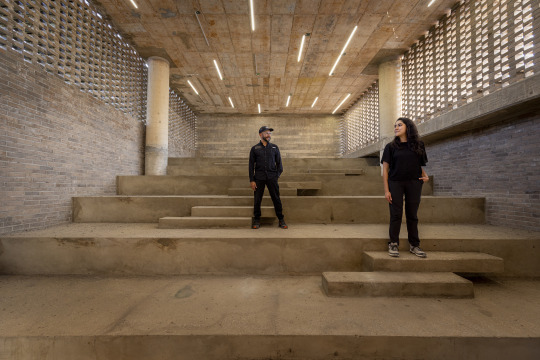
Daniel Díaz Vidaurri and Fernanda Tejeda Torres formed LAU. Photo © Fernando Díaz Vidaurri
LAU is just one of some Mexican offices (which we will present in the following months) that took a part in the Urban Improvement Program, part of the new government and initiative of the Ministry for Agrarian, Territorial and Urban Development.
Román Guillermo Meyer Falcón, the minister at this department, states that the project within "built architectures for communities have improved the perception of security in the communities and provided conditions for the creation of social ties and the strengthening of social cohesion. In favour of social justice, the program focuses on neighbourhood improvement interventions in Chiapas, Oaxaca, Tabasco and Veracruz, to in such way create public spaces of the most marginalized communities and raise their quality of life."

The proposal of an Urban Acupuncture by LAU for the Cedar market of Comitán de Dominguez.
The program focuses on the revitalization of urban areas through the improvement of infrastructure, public spaces and basic services, with the aim of boosting the socioeconomic development of local communities and promoting urban equity. Through the program many offices (as well LAU) collaborated with municipal authorities, civil organizations and the community in general to identify the priority needs of each area and design interventions that comprehensively respond to these needs.


A restructuration of a neglected area into a sport centre for kids and teenagers by LAU in La Cebadilla in Tapachula, Chiapas. Photo © SEDATU
In four years of hard work the Urban Improvement Program has developed actions in 25 Mexican states and 135 municipalities with 931 works, 38,000 actions and more than eighty urban and metropolitan and territorial planning plans or programs, among others. All of them have directly influenced life of millions of dwellers with democratisation of the access to services, but also within the creation of a new sustainable development of the common spaces. Within such an initiative, offering the opportunity to create community spaces is possible to influence the reduction of crime, drug abuse among youngsters and the stronger integration of urban and rural population in creation of such spaces. Community spaces enable as well a strong support for indigenous communities and allow them to assume a new commitment to the protection of the biodiversity and sustainable land use.
From Small To XXL Urban Acupunctures
The approach used at the LAU includes aspects such as accessibility, safety, environmental sustainability and the promotion of citizen participation. With such a program the new government in Mexico have managed to transform neighbourhoods, generating positive impacts on the quality of life of the inhabitants, promoting a sense of belonging and contributing to the comprehensive development of cities. However, there is always the same approach for urban acupunctures, from small to XXL scale, that always connects space with the communities.



Renovation of the park in Barrio Tikal, Comitan de Dominguez by LAU. Photo © SEDATU
The renovation of the park in Tikal for example improve the infrastructure within the promotion of the recreation of the population in the neighborghood. The project addresses, among others, the gender equity and safety, with the inclusion of spacious, illuminated environments that allow free access to space, but also reduces the incidence of crime and drug use among youngsters.
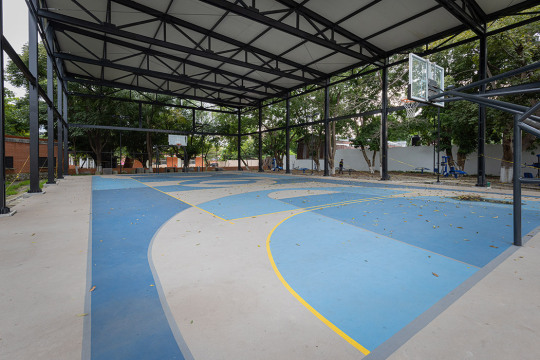
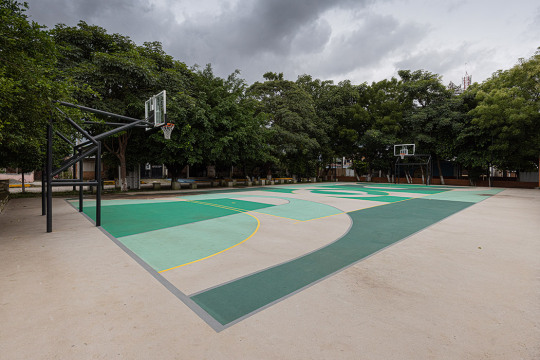
The transformation of the neglected park in San Angel del Pedregal in Tapachula, Chiapas into a playground by LAU. Photo © Fernando Díaz Vidaurri
The bigger, more strategic projects are suggesting architectural design strategies such as integration of endemic plant species, use of pavements that allow water infiltration into the soil, division of sanitary and rainwater networks, use of clean technologies, among others, public policy against climate change.
As such, the Community development center in Tapachula represent a part of a broad strategy to support the development of capacities and opportunities of the population, which contributes to the transformation of nearby colonies and peri-urban areas into safer, more productive and habitable places. The project promotes social integration, community development, while coexistence and collective identity are strengthened through access to services such as basic medical care, mental health, social work, training for work, sport and recreation, care for minors, from the infant level to the preschool level, direct food aid and social work.



Community development center by LAU in Tapachula, Chiapas. Photo © Fernando Díaz Vidaurri
The Community Development Center in Antiguo Rastro Municipal provides the community with a safe space of free access where activities on art, trade workshops, exhibitions of local artists, music, indigenous language classes, customs can be developed and encouraged by users to adapt the space for this, create a community that is proud of its roots, customs and can expose and represent it freely in this architectural complex where by knowing the transformation of use and history so reach more people with art and culture and generate a better quality of life without social differences, race, religion or customs.
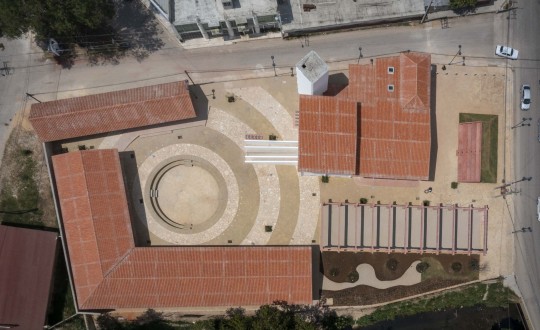
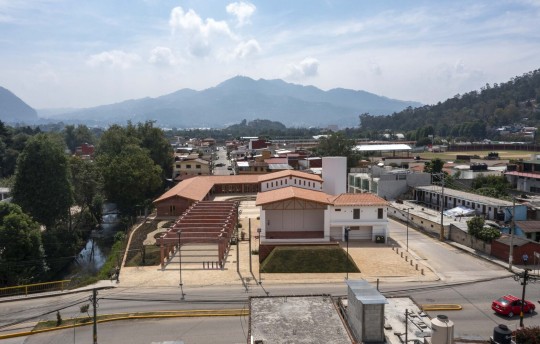

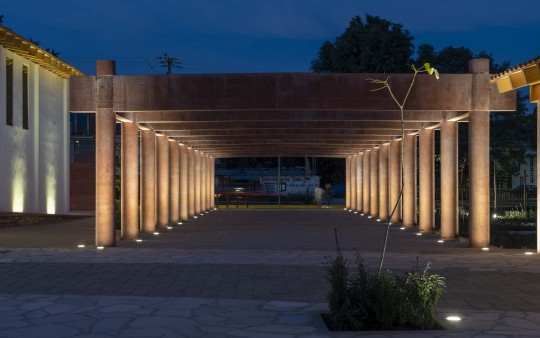

The Community Development Center in Antiguo Rastro Municipal. Photo © Jaime Navarro
1 note
·
View note
Text
How to Leverage Automation in Salesforce Marketing Cloud as a Consultant

Introduction
In the ever-evolving landscape of digital marketing, efficiency and precision are paramount. Salesforce Marketing Cloud, a robust platform designed to streamline marketing efforts, offers a plethora of automation tools that can significantly enhance the effectiveness of campaigns. As a consultant navigating the Salesforce Marketing Cloud Consultant, understanding how to leverage automation is key to delivering exceptional results. In this blog post, we'll explore strategies and best practices for consultants looking to harness the power of automation within Salesforce Marketing Cloud.
Mapping Out Customer Journeys
Successful marketing campaigns often revolve around delivering the right message at the right time. With Salesforce Marketing Cloud, consultants can leverage automation to map out intricate customer journeys. Utilize Journey Builder to design personalized, multi-channel campaigns that respond dynamically to customer interactions. From email marketing to social media and beyond, automation allows consultants to orchestrate seamless and targeted customer experiences.
Email Marketing Automation
Email remains a cornerstone of digital marketing, and Marketing Cloud excels in automating email campaigns. Consultants can leverage automation tools like Email Studio to create personalized email campaigns triggered by specific customer behaviors or events. Automated drip campaigns, welcome series, and re-engagement emails can be set up to nurture leads and maximize engagement without manual intervention.
Data Segmentation and Personalization
Automation in Salesforce Marketing Cloud extends beyond campaign execution; it also plays a crucial role in data segmentation and personalization. As a consultant, use Automation Studio to segment your audience based on demographics, behavior, or other criteria. This segmentation can then be leveraged to deliver highly personalized content, increasing the relevance of your marketing efforts.
Social Media Management
Integrating social media into your marketing strategy is made seamless with Marketing Cloud's Social Studio. Consultants can automate social media posting, monitor social conversations, and engage with audiences in real-time. By automating routine tasks, consultants can focus on crafting compelling content and strategic social media initiatives that align with overall marketing objectives.
Lead Scoring and Qualification
Efficient lead management is crucial for a successful marketing strategy. Automation in Marketing Cloud allows consultants to implement lead scoring models that automatically assess and prioritize leads based on predefined criteria. By automating lead qualification processes, consultants can ensure that sales teams receive well-qualified leads, optimizing the conversion process.
A/B Testing Automation
Optimizing marketing campaigns requires continuous testing and refinement. Consultants can leverage automation to streamline A/B testing processes, allowing for quick experimentation with various elements such as subject lines, content, and images. This iterative approach enables data-driven decision-making and ensures that marketing strategies are continually refined for optimal performance.
Monitoring and Analytics Automation
Automation is not only about execution but also about monitoring and analyzing campaign performance. Consultants can set up automated reports and dashboards within Marketing Cloud to gain real-time insights into key performance metrics. This enables quick identification of trends, areas for improvement, and the ability to make data-driven adjustments on the fly.
Conclusion
As a consultant in the dynamic realm of Salesforce Marketing Cloud, mastering automation is the key to delivering impactful and efficient marketing campaigns. By leveraging the platform's diverse automation tools, consultants can streamline processes, enhance personalization, and drive meaningful engagement with target audiences. Stay at the forefront of digital marketing by embracing automation within Salesforce Marketing Cloud and unlock new levels of success for your clients and your consultancy.
Ready to elevate your career as a Salesforce Marketing Cloud Developer? Unlock the full potential of automation and take your skills to new heights with Cloud Analogy, a leading expert in Salesforce solutions. Enroll now in Cloud Analogy's comprehensive Salesforce Marketing Cloud Developer course and gain hands-on experience in leveraging automation for impactful marketing campaigns.
Don't miss the opportunity to become a certified Salesforce Marketing Cloud Developer with Cloud Analogy's expert guidance. Click here to explore the details of the course and propel your career forward. Master the intricacies of Marketing Cloud automation and join the ranks of successful professionals who have enhanced their expertise with Cloud Analogy. Seize this chance to shape your future in Salesforce marketing automation.
0 notes
Text
A Holistic Approach to Diabetes Management and Weight Loss
Introduction
In today's fast-paced society, the pursuit of a healthy lifestyle has become more imperative than ever. Addressing health concerns like obesity and diabetes has become a priority for those who value their physical and emotional well-being. Among the plethora of methods available, one ancient practice stands out as a beacon of holistic health: yoga. This article explores the transformative benefits of yoga, unveiling its potential in weight loss and diabetes management. Additionally, we'll guide you in discovering yoga studios tailored specifically for women in your area. Let's embark on a journey to unravel the concealed secrets of yoga!
Utilizing Yoga for Weight Loss
In the quest for weight loss, yoga offers a distinctive and integrative strategy. While it may not be as physically demanding as high-intensity interval training (HIIT) or weightlifting, yoga boasts numerous positive effects that contribute to weight control. Here's how yoga aids in shedding those extra pounds:
Boosting Metabolism
Certain yoga postures and sequences stimulate the endocrine system, particularly the thyroid gland. This stimulation enhances metabolic rate, leading to increased calorie expenditure, a valuable asset in weight loss.
Muscle Toning and Growth
Yoga's emphasis on stretching, balancing, and strength training engages various muscle groups, promoting lean muscle growth. The development of lean muscle mass contributes to weight management as maintaining muscle requires more calories than maintaining fat.
Stress Reduction and Emotional Well-being
Stress and emotional eating often hinder weight loss. Yoga's focus on relaxation and awareness training equips practitioners with effective tools to cope with stress. By fostering a healthier connection with food and addressing emotional triggers, yoga indirectly aids in weight loss.
The Role of Yoga For Diabetes Management
Diabetes, a prevalent chronic metabolic condition, necessitates a multifaceted approach to control. In addition to medical interventions, adopting a healthy lifestyle is crucial. Regular practice of yoga can significantly contribute to diabetes management, offering the following benefits:
Improved Insulin Sensitivity
Regular yoga practice has been shown to enhance insulin sensitivity, facilitating improved glucose uptake by cells. This, coupled with controlled breathing methods, positions yoga as an effective supplementary treatment for type 2 diabetes.
Cortisol and Stress Regulation
Yoga effectively lowers cortisol and alleviates chronic stress, both of which adversely affect glucose metabolism. The stress-reducing benefits of yoga aid in maintaining healthier blood sugar levels and reducing the risk of diabetes-related complications.
Enhanced Blood Flow and Nerve Function
Specific yoga asanas and pranayama are designed to improve blood circulation and nerve function. Given the prevalence of issues like poor circulation and nerve damage in diabetes, yoga emerges as a preventive or therapeutic exercise for diabetic neuropathy.
Yoga Classes Near Me Only For Ladies in Your Area
Recognizing the need for a safe and supportive space, women-only yoga studios have gained popularity. Here are effective strategies for finding these specialized classes:
Online Search:
Conduct a quick online search using terms like "women-only yoga classes" or "yoga classes for ladies near me." Utilize search engines and directories to discover yoga studios or teachers catering specifically to women.
Community Engagement:
Join local community groups or social media forums. Connect with like-minded individuals to gain recommendations for women-only yoga classes. The shared experiences and insights from these communities can be invaluable in making an informed choice.
Local Outreach:
Reach out to local yoga studios, wellness centers, and community facilities. Inquire about classes that cater to women's preferences. Word-of-mouth recommendations from women who have attended such classes can provide valuable insights.
Conclusion
Yoga, an ancient practice intertwining spirituality with physical and mental well-being, holds countless benefits for the body and mind. From enhanced metabolism and insulin sensitivity to stress reduction and heightened awareness, yoga offers a comprehensive approach to health. By seeking out women-only sessions, you can create a welcoming and inspiring space to embark on your yoga journey. If longevity, happiness, and fulfillment are what you seek in life, consider integrating yoga into your holistic well-being routine. Let yoga be the key to unlocking a longer, happier, and more fulfilling life.
0 notes
Text
V & A Rapid Response collecting research
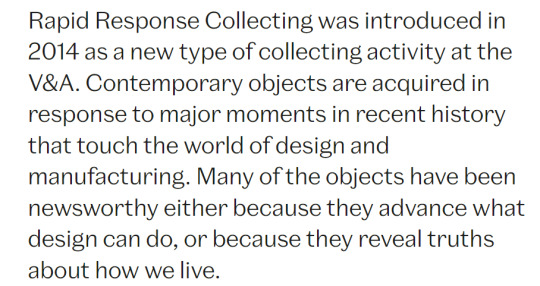
"reveal truths about how we live"- collecting as a methodology for displaying a range of lived experiences. Paradox of items in collections often being collected from individuals but as a means to understand who we are as a collective body. How many items are required to fulfill this task, or is it more an impossible task- gathering a large enough quantity/ a wide enough range to start to piece together the commonalities amongst us?? I think this collection really brings to life an idea we came across in one of our taught studio lessons which was that collecting is hoarding but with a vision for the future.
"each new acquisition raises a different question about economic, political and social change, globalisation, technology and the law"
Rapid Response collecting suggests that the way the world is unfolding in dynamic and unexpected ways, and that this approach has designed been designed in line with this. Rather than collecting being a slow and drawn-out act, this approach is perhaps more reactive,, selecting those items which are most essential. Knowing that these items have been collected as a 'response' to the times (the social, politicial, economic etc. climate) also which gives an added sense of gravity/ significance with which we view each item, which changes our relationshio with the items as viewer (perhaps thinking more closely about what these items might say about us as a society etc.)
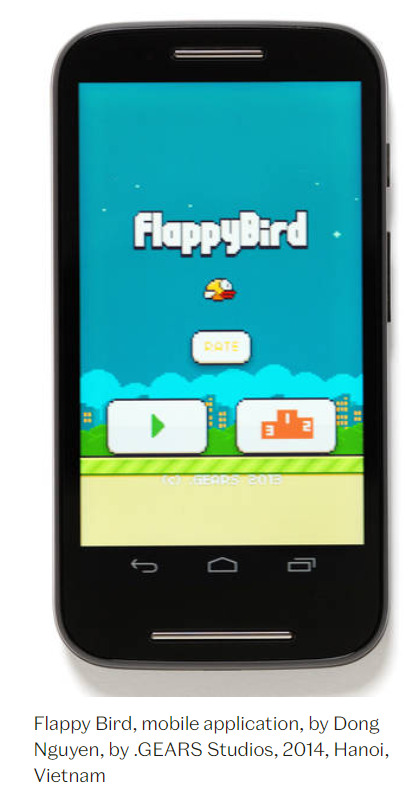


Simple captioning systems lists 1. Name of specific item 2. What type of item it is 3. When it was made 4. Where it was made
Under this section there is a more in depth explanation of the significance of this item, as well as the sub-categories that the item fits under
Online vs. digital collections
Online website allows for casual browsing with the option to find out more about the object. I think the difference between this collection being online vs. how it might look if it were an in-person collection is quite striking here. Online we can't really get a full sense of scale (despite the dimensions being listed) and the final form that the items take online (ie. the difference between seeing an old phone with the Flappy Bird app installed vs. an image on a laptop of a phone displaying Flappy Bird) creates further layers of separation between the viewer and the item which in some cases makes the items more difficult to engage with on an immediate level, but does have teh significant benefit being able to more easily access a wider volume of items.


At the bottom of the website page I found this disclaimer which I thought was interesting. It encourages viewers of the collection/ archive to engage with helping shape the future of the collection by identifying historical language/ ideas present that could cause offense. I think the idea of censorship and redaction is interesting in cases such as these as the level of appropriate use of disclaimers or intervention is far from clear-cut. At best I think it's a good thing that the V&A is appealing to the wider public and encouraging discussion and debate to work through these complex scenarios and help shape understanding for collections to come. The wider the pool of participants in such debates, the greater the range of perspectives brought to the table and therefore the more informed decision-making can become on behalf of large institutions such as the V&A
0 notes
Text
Solar Steps affordable housing concept
Nicole Cao presents “Solar Steps”, a proposed affordable residence featuring a triple-storey ETFE greenhouse atrium that explores how threshold materiality and operability could create new forms of collective living that empower residents to make their own spaces. Sited in Brampton, Ontario, the project was completed for a third-year design studio led by professor Adrian Blackwell at the University of Waterloo entitled “Humans are more important than real estate”. The colourfully illustrated project recently won the Azure Magazine A+ Student Award for 2023.
Also Read | 10 kitchen design ideas inspired by farmhouse style
The design concept layers architectural thresholds to redefine the relationships between interior and exterior climates, and between domestic and public programs. By varying circulatory, visual, and auditory porosity, the operable partitions, connections, openings, and other architectural interventions grant spatial agency to residents.
Also Read | Beginners guide: Creative ideas for styling your new living space
The triple-height greenhouse structure covers a shared terrace on the private side of the building, which becomes a semi-public, semi-exterior mediator in addition to being a climate strategy. While occupants remain protected from wind and precipitation, sunlight filtering in through the translucent high ceiling evokes the outdoors in a space that is comfortable and habitable year-round.


Deciduous interior plantings add to the seasonal dynamic, while traces of resident activity, including furniture, clotheslines, bikes, easels, and other personal belongings, populate the edge of the terrace and strengthen the community-made social atmosphere. These qualities of comfort and accessibility draw out and concentrate resident activity under the greenhouse terrace. The result is a new shared living condition that encourages conversations and interactions between neighbours.
Also Read | Tips to care for your houseplants this winter
As a result of the layered scheme, residents regularly interact with or across threshold elements to adapt the spaces in between to changing programmatic needs. Operable bi-fold doors allow the greenhouse condition to bleed past the entrance boundaries of each unit’s south face to merge with each private living quarter when desired. Sliding doors, sliding-walls, and operable wall openings within the units likewise divide and merge spaces to accommodate large gatherings or quiet study zones as needed for diverse housing situations, including multi-generational families and co-housing groups.
Also Read | Timber hybrid office ensemble EDGE Suedkreuz Berlin
The street-facing arcade of Solar Steps joins the residence to the urban context through its sheltering structure and commercial program. Storefront space attached to first-floor units gives residents direct access to small-business opportunities. Oncoming pedestrians, drawn to both commercial activity and shelter from weather and traffic, animate the arcade into a lively marketplace whose accessibility and atmosphere become the foundations of a new gathering centre for the broader urban community.
Also Read | Kareena Kapoor Khan’s new home in Bandra with European styled decor & wooden detailing
Through a layering of thresholds and inhabited intermediary spaces, the individual resident’s relationship to their neighbours and to the broader community become at the same time more connected and more flexible: Agency over where and how to draw the boundary between personal and community space is given to the residents themselves.
Also Read | Shiro Kuramata’s Samba-M shines again with Ambientec at the supersalone in Milan
Technical sheet
Project name: Solar Steps
Location (proposed): Brampton, Ontario
Course: ARCH 392
Supervising professor: Adrian Blackwell
Designer: Nicole Cao
Type: Affordable housing residence
Building footprint area: 1500sm
Building footprint dimensions: 19m x 80m
Building height: 19.5m
Materials: Steel, ETFE
Building net floor area: 5845sm
Number of residents: 100-150
Source Link
#home decor#home design#home decore#interior design#home#interiors#home improvement#home & lifestyle
0 notes
Text
Apartments With Residence Amenities You Will Love
One of the residential amenities at 200 West Ocean you'll love is the floor-to-ceiling windows. Floor-to-ceiling windows maximize the amount of natural light entering a room, improving mood, enhancing productivity, and creating a sense of well-being. They also let you enjoy unobstructed views of the surrounding environment. Go to 200 West Ocean for apartments near Long Beach with amenities designed to satisfy its residents. Their spacious studios, one-bedroom, two-bedroom, and three-bedroom units also have motorized window shades, quartz countertops, custom closets, and Italian cabinetry. In addition, they come with stainless steel appliances and an in-unit washer and dryer. They also have penthouse units for an ultimate luxury lifestyle.
The Climate in Long Beach, California
Winters in Long Beach are mild and relatively dry, with average daytime temperatures during winter months ranging from the mid-60s to the low 70s Fahrenheit. Summers are warm and mostly dry, with average daytime temperatures ranging from the high 70s to mid-80s Fahrenheit. Long Beach experiences most of its rainfall between late fall and early spring. The wettest months are usually January and February, with average rainfall ranging from 2 to 3 inches. The rest of the year tends to be relatively dry, with minimal rain. The city enjoys an average of over 300 days of sunshine annually, contributing to its pleasant climate and outdoor recreational opportunities.
El Dorado Nature Center
The El Dorado Nature Center is situated within El Dorado Regional Park, encompassing 105 acres of natural habitat. Despite being located in a suburban area, the nature center provides a peaceful and serene environment, with its trails winding through wetlands, forests, and meadows. It features several nature trails that meander through different habitats, allowing you to observe and appreciate the local flora and fauna. The courses are well-maintained and offer a variety of lengths and difficulty levels to accommodate different fitness levels and interests. Along the trails, you may also encounter a diverse range of wildlife, including birds, reptiles, amphibians, and mammals.
Police Shoot Horror Spree Suspect
The colloquial phrase "horror spree" typically refers to a series of horrifying incidents or crimes committed by an individual or group within a relatively short period. It is characterized by a rapid succession of violent events that cause fear, panic, and distress within a community or society. Many individuals who engage in horror sprees may have underlying mental health issues. These can include conditions such as untreated or undiagnosed mental illnesses, personality disorders, feelings of isolation, anger, or a distorted perception of reality. Efforts to prevent horror sprees require a comprehensive and multifaceted approach involving mental health support, community engagement, early intervention, responsible gun control measures, and addressing societal issues such as social isolation, discrimination, and extremism. Click here to read more.
Link to Map
Driving Direction
El Dorado Nature Center
7550 E Spring St, Long Beach, CA 90815, United States
Get on I-405 N from E Spring St and N Studebaker Rd
6 min (2.4 mi)
Continue on I-405 N. Take I-710 S to W Shoreline Dr. Take exit 1C from I-710 S
11 min (10.5 mi)
Continue on W Shoreline Dr. Drive to W Ocean Blvd
4 min (1.7 mi)
200 West Ocean
200 W Ocean Blvd,
Long Beach, CA 90802, United States
0 notes
Text









Goth Stitch / GrandmaBeWildin/ SuzyQueue
To preface: I am all about letting people stitch what they enjoy. I will not police someone's hobby, but I CAN provide information, and stitcher can be able to make a well informed choice on whether or not to buy and or stitch her patterns. I will also preface what is not in here: She's been known to steal from other designers. To do things like take elements and use them for her own. Art theft is NOT ok.
But if you support/defend her in any way, you can go and unfollow me now.
I was given permission by https://www.instagram.com/badstitched/ to share these on Tumblr. This is the short version. But out side of these IG story screen shots, it goes so much deeper into why she is clearly unstable. It's NOT ok to stalk and harass other designers with credible threats, especially when another designer: Night Spirit Studio, is going through chemo/cancer treatments. That is 100% NOT ok. This post only scratches the surface.
Another moderator for a FB cross stitching group came forward in private to share information about this woman, after having much closer/personal interactions with Goth Stitch, as she was also a moderator of a few FB cross stitch groups.. I was made aware of the fullness of it, as a fellow designer of the community. And I am glad I was made aware. It meant that I could do my part as well, to spread the word, as this person is clearly unstable.
I URGE you to keep reading below, as I will share some very telling bullet points into why it more than highly suggests how unstable Goth Stitch is. She is a threat to the stitching community and to us designers, whether big or small. We don't feel safe, and I for one, will stand sturdy in the face of this because this behavior is NOT ok and WILL NOT be tolerated. This is my Sturdy Stance, and should she, or her flying monkies come my way, I will stand Sturdy in the face of this.
And after you read, please. I REALLY HIGHLY URGE you to reblog this and spread the word far and wide. Spread this to stitching friends. Share if you are a designer yourself. Share everywhere.
Your reblog tells the stitching and fiber arts community that you don't condone this behavior either, and that you are taking a stance against her, her community, her art theft, and her patterns. We need all the support we can get.
Feel free to message me if you've had any interaction with her that was not of a positive nature. I will keep it private and confidential unless I am given permission to share as a means to further add proof that she's not a good human being.
Thank you,
Tanya G. @SturdyNerdyStitchery
so, click "keep reading" to get the rest
Anyway, This person who has come forward to share goth stitch information has worked 20 years in violence/gang intervention programs, and I feel, this person has credible experience into the bullet points below. I will run down some main points that were said/described/told.
Goth Stitch = Aggressor who has threatened the physical safety of more than one person in the fiber arts community
is hyper-paranoid
fixated on the big designers, especially Night Spirit Studio
she is manipulative, despite the ever so sweet sweet personality on the outside
has said several times that she hopes Night Spirit Studio recovers from cancer so that the vendetta can be perused even more energetically.
An extremely motivated person, obsessed with Night Spirit Studio and The Witchy Stitcher.
She has socks/flying monkies in multiple social media stitching groups who report back to her with intel.
She is so emotionally engaged with Night Spirit Studio and The Witchy Stitcher that she tracks their sales numbers, whether they have attained star seller status, etc. Tracks religiously. As in, she tracks it even by the hour.
Fanatical about knowing how many members are in their groups. It was told that at one point, she was trying to mathematically calculate an exact date that her group would reach equilibrium with The Witchy Stitcher: Stitch Witch Hollow.
checks group member numbers weekly
other moderators in other groups can collaborate on her manipulative and bullying behaviors.
she DNGAF about your well being, the well being of your shop, or if you succeed. She is 100% profit driven.
based on this informant' 20 years in voilence/gang intervention programs: Goth stitch/GrandmaBeWildin' "is a dangerous and unstable person with a persecution complex who is obsessed with getting vengeance for her failure to succeed in business.
So, interact with her how ever you wish, but be well informed when you do. Or, don't interact with her at all. She needs to be stopped. But please don't stoop down to her level. Should she or any of her flying monkeys come your way, don't engage. Don't give her any ammunition. Don't give her a reason to keep going on this vendetta.
So, I'm taking a stance. Will you?
#Cross Stitch#Cross Stitching#Goth Stitch#X Stitch#x Stitching#Share#PSA#Cross Stitching Community#Cross Stitching Love#Please share#Please help reblog#I need this to blow up fast#This is important#She is a threat to our safety with how unstable her behaviors are should they escelate further.#Should she come after me#Or other designers and stitchers
62 notes
·
View notes
Text
Coronagrifting: A Design Phenomenon
We now interrupt our regularly scheduled content to bring you a critical essay on the design world. I promise you that this will also be funny.
This morning, the design website Dezeen tweeted a link to one of its articles, depicting a plexiglass coronavirus shield that could be suspended above dining areas, with the caption “Reader comment: ‘Dezeen, please stop promoting this stupidity.’”

This, of course, filled many design people, including myself, with a kind of malicious glee. The tweet seemed to show that the website’s editorial (or at least social media) staff retained within themselves a scintilla of self-awareness regarding the spread a new kind of virus in its own right: cheap mockups of COVID-related design “solutions” filling the endlessly scrollable feeds of PR-beholden design websites such as Dezeen, ArchDaily, and designboom. I call this phenomenon: Coronagrifting.
I’ll go into detail about what I mean by this, but first, I would like to presenet some (highly condensed) history.
From Paper Architecture to PR-chitecture
Back in the headier days of architecture in the 1960s and 70s, a number of architectural avant gardes (such as Superstudio and Archizoom in Italy and Archigram in the UK) ceased producing, well, buildings, in favor of what critics came to regard as “paper architecture.” This “paper architecture” included everything from sprawling diagrams of megastructures, including cities that “walked” or “never stopped” - to playfully erotic collages involving Chicago’s Marina City. Occasionally, these theoretical and aesthetic explorations were accompanied by real-world productions of “anti-design” furniture that may or may not have involved foam fingers.

Archigram’s Walking City (1964). Source.
Paper architecture, of course, still exists, but its original radical, critical, playful, (and, yes, even erotic) elements were shed when the last of the ultra-modernists were swallowed up by the emerging aesthetic hegemony of Postmodernism (which was much less invested in theoretical and aesthetic futurism) in the early 1980s. What remained were merely images, the production and consumption of which has only increased as the design world shifted away from print and towards the rapidly produced, easily digestible content of the internet and social media.
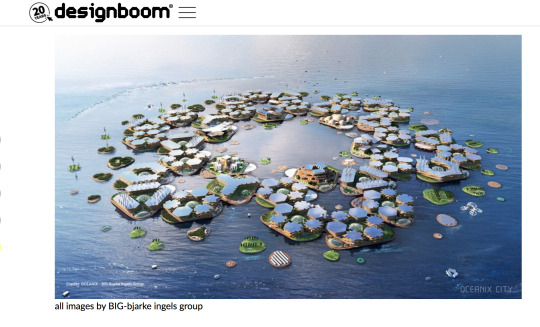
Architect Bjarke Ingels’s “Oceanix” - a mockup of an ecomodernist, luxury city designed in response to rising sea levels from climate change. The city will never be built, and its critical interrogation amounts only to “city with solar panels that floats bc climate change is Serious” - but it did get Ingels and his firm, BIG, a TED talk and circulation on all of the hottest blogs and websites. Meanwhile, Ingels has been in business talks with the right-wing climate change denialist president of Brazil, Jair Bolsonaro. (Image via designboom)
Design websites are increasingly dominated by text and mockups from the desks of a firm’s public relations departments, facilitating a transition from the paper-architecture-imaginary to what I have begun calling “PR-chitecture.” In short, PR-chitecture is architecture and design content that has been dreamed up from scratch to look good on instagram feeds or, more simply, for clicks. It is only within this substance-less, critically lapsed media landscape that Coronagrifting can prosper.
Coronagrifting: An Evolution
As of this writing, the two greatest offenders of Coronagrifting are Dezeen, which has devoted an entire section of its website to the virus (itself offering twelve pages of content since February alone) and designboom, whose coronavirus tag contains no fewer than 159 articles.
Certainly, a small handful of these stories demonstrate useful solutions to COVID-related problems (such as this one from designboom about a student who created a mask prototype that would allow D/deaf and hard of hearing people to read lips) most of the prototypes and the articles about them are, for a lack of a better word, insipid.
But where, you may ask, did it all start?
One of the easiest (and, therefore, one of the earliest) Coronagrifts involves “new innovative, health-centric designs tackling problems at the intersection of wearables and personal mobility,” which is PR-chitecture speak for “body shields and masks.”
Wearables and Post-ables
The first example came from Chinese architect Sun Dayong, back at the end of February 2020, when the virus was still isolated in China. Dayong submitted to Dezeen a prototype of a full mask and body-shield that “would protect a wearer during a coronavirus outbreak by using UV light to sterilise itself.” The project was titled “Be a Bat Man.” No, I am not making this up.
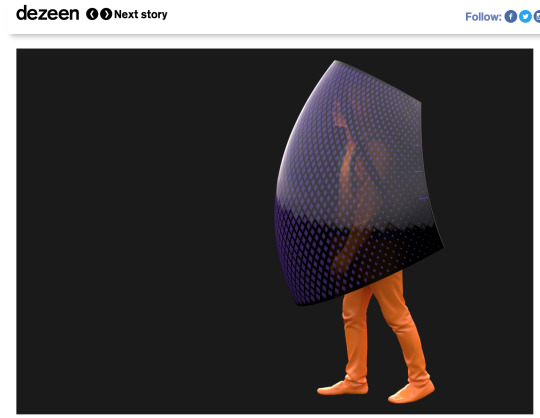
Screenshot of Dayong’s “Be a Batman” as seen on the Dezeen website.
Soon after, every artist, architect, designer, and sharp-eyed PR rep at firms and companies only tangentially related to design realized that, with the small investment of a Photoshop mockup and some B-minus marketing text, they too could end up on the front page of these websites boasting a large social media following and an air of legitimacy in the field.
By April, companies like Apple and Nike were promising the use of existing facilities for producing or supplying an arms race’s worth of slick-tech face coverings. Starchitecture’s perennial PR-churners like Foster + Partners and Bjarke Ingels were repping “3D-printed face shields”, while other, lesser firms promised wearable vaporware like “grapheme filters,” branded “skincare LED masks for encouraging self-development” and “solar powered bubble shields.”
While the mask Coronagrift continues to this day, the Coronagrifting phenomenon had, by early March, moved to other domains of design.
Consider the barrage of asinine PR fluff that is the “Public Service Announcement” and by Public Service Announcement, I mean “A Designer Has Done Something Cute to Capitalize on Information Meant to Save Lives.”
Some of the earliest offenders include cutesy posters featuring flags in the shape of houses, ostensibly encouraging people to “stay home;” a designer building a pyramid out of pillows ostensibly encouraging people to “stay home”; and Banksy making “lockdown artwork” that involved covering his bathroom in images of rats ostensibly encouraging people to “stay home.”

Lol. Screenshot from Dezeen.
You may be asking, “What’s the harm in all this, really, if it projects a good message?” And the answer is that people are plenty well encouraged to stay home due to the rampant spread of a deadly virus at the urging of the world’s health authorities, and that these tone-deaf art world creeps are using such a crisis for shameless self promotion and the generation of clicks and income, while providing little to no material benefit to those at risk and on the frontlines.
Of course, like the mask coronagrift, the Public Service Announcement coronagrift continues to this very day.
The final iteration of Post-able and Wearable Coronagrifting genres are what I call “Passive Aggressive Social Distancing Initiatives” or PASDIs. Many of the first PASDIs were themselves PSAs and art grifts, my favorite of which being the designboom post titled “social distancing applied to iconic album covers like the beatle’s abbey road.” As you can see, we’re dealing with extremely deep stuff here.
However, an even earlier and, in many ways more prescient and lucrative grift involves “social distancing wearables.” This can easily be summarized by the first example of this phenomenon, published March 19th, 2020 on designboom:

Never wasting a single moment to capitalize on collective despair, all manner of brands have seized on the social distancing wearable trend, which, again, can best be seen in the last example of the phenomenon, published May 22nd, 2020 on designboom:

We truly, truly live in Hell.
Which brings us, of course, to living.
“Architectural Interventions” for a “Post-COVID World”
As soon as it became clear around late March and early April that the coronavirus (and its implications) would be sticking around longer than a few months, the architectural solutions to the problem came pouring in. These, like the virus itself, started at the scale of the individual and have since grown to the scale of the city. (Whether or not they will soon encompass the entire world remains to be seen.)
The architectural Coronagrift began with accessories (like the designboom article about 3D-printed door-openers that enable one to open a door with one’s elbow, and the Dezeen article about a different 3D-printed door-opener that enables one to open a door with one’s elbow) which, in turn, evolved into “work from home” furniture (”Stykka designs cardboard #StayTheF***Home Desk for people working from home during self-isolation”) which, in turn, evolved into pop-up vaporware architecture for first responders (”opposite office proposes to turn berlin's brandenburg airport into COVID-19 'superhospital'”), which, in turn evolved into proposals for entire buildings (”studio prototype designs prefabricated 'vital house' to combat COVID-19″); which, finally, in turn evolved into “urban solutions” aimed at changing the city itself (a great article summarizing and criticizing said urban solutions was recently written by Curbed’s Alissa Walker).

There is something truly chilling about an architecture firm, in order to profit from attention seized by a global pandemic, logging on to their computers, opening photoshop, and drafting up some lazy, ineffectual, unsanitary mockup featuring figures in hazmat suits carrying a dying patient (macabrely set in an unfinished airport construction site) as a real, tangible solution to the problem of overcrowded hospitals; submitting it to their PR desk for copy, and sending it out to blogs and websites for clicks, knowing full well that the sole purpose of doing so consists of the hope that maybe someone with lots of money looking to commission health-related interiors will remember that one time there was a glossy airport hospital rendering on designboom and hire them.
Enough, already.
Frankly, after an endless barrage of cyberpunk mask designs, social distancing burger king crowns, foot-triggered crosswalk beg buttons that completely ignore accessibility concerns such as those of wheelchair users, cutesy “stay home uwu” projects from well-to-do art celebrities (who are certainly not suffering too greatly from the economic ramifications of this pandemic), I, like the reader featured in the Dezeen Tweet at the beginning of this post, have simply had enough of this bullshit.
What’s most astounding to me about all of this (but especially about #brand crap like the burger king crowns) is that it is taken completely seriously by design establishments that, despite being under the purview of PR firms, should frankly know better. I’m sure that Bjarke Ingels and Burger King aren’t nearly as affected by the pandemic as those who have lost money, jobs, stability, homes, and even their lives at the hands of COVID-19 and the criminally inept national and international response to it. On the other hand, I’m sure that architects and designers are hard up for cash at a time when nobody is building and buying anything, and, as a result, many see resulting to PR-chitecture as one of the only solutions to financial problems.
However, I’m also extremely sure that there are interventions that can be made at the social, political, and organizational level, such as campaigning for paid sick leave, organizing against layoffs and for decent severance or an expansion of public assistance, or generally fighting the rapidly accelerating encroachment of work into all aspects of everyday life – that would bring much more good and, dare I say, progress into the world than a cardboard desk captioned with the hashtag #StaytheF***Home.
Hence, I’ve spent most of my Saturday penning this article on my blog, McMansion Hell. I’ve chosen to run this here because I myself have lost work as a freelance writer, and the gutting of publications down to a handful of editors means that, were I to publish this story on another platform, it would have resulted in at least a few more weeks worth of inflatable, wearable, plexiglass-laden Coronagrifting, something my sanity simply can no longer withstand.
So please, Dezeen, designboom, others – I love that you keep daily tabs on what architects and designers are up to, a resource myself and other critics and design writers find invaluable – however, I am begging, begging you to start having some discretion with regards to the proposals submitted to you as “news” or “solutions” by brands and firms, and the cynical, ulterior motives behind them. If you’re looking for a guide on how to screen such content, please scroll up to the beginning of this page.
----
If you enjoyed this article, please consider subscribing to my Patreon, as I didn’t get paid to write it.
5K notes
·
View notes
Text
My Top Ten Overlooked Movies With Female Leads In No Particular Order
Note: When you see this emoji (⚠️) I will be talking about things people may find triggering, which are spoilery more often then not. I mention things that I think may count as triggers so that people with them will be aware before going in to watch any of these.
Edited: 3/16/21
Hanna (2011)

So, before I get into why you should watch this movie, I just want to take a moment to say why it's near and dear to my heart. Growing up as a queer kid in the early 2000s, seeing portrayals of people like or similar to myself on anything was rare at best. It was mostly in more "adult" movies or shows that my parents would occasionally let me watch with them that I'd see any lgbtq+ rep at all. Often times they were either walking stereotypes, designed to be buried, evil, or all three.
Then here comes this PG-13 action thriller with a wonderfully written main female lead who, at the time, was close to my age, and who got to kiss another girl (her very first friend, Sophie) on screen in an extremely tender and heartwarming scene. To say the least, it was a life changing moment for me personally.
Now that I've gotten that out of the way, Hanna is a suspenseful movie about a child super-soldier named, you guessed it, Hanna (played by Saoirse Ronan) and her adoptive (?) father Erik Heller (played by Eric Bana) exiting the snowy and isolated wilderness of their home and taking on the shadowy CIA operative, Marissa Wiegler (played by Cate Blanchette) who wants Erik dead and Hanna for herself for mysterious reasons.
It also has an amazing soundtrack by the Chemical Brothers, great action scenes, and it has an over arching fairytale motif, which I'm always a sucker for.
⚠️ Mild blood effects, some painful looking strikes, various character deaths, and child endangerment all feature in this film. However, given its PG-13 rating, a majority of viewers are presumably able to handle this one. Still, be aware of these going in.
Sidenote: It's recently gotten a TV adaptation on Amazon TV, although I have not watched it, and do not know if Hanna and Sophie's romantic/semi-romantic relationship has transferred over.
A Simple Favor

A Simple Favor is a "black-comedy mystery thriller" centered entirely around the relationship between two mothers, the reclusive, rich, mysterious, and regal Emily (played by Blake Lively), and the local recently widowed but plucky mommy blogger, Stephanie (played by Anna Kendrick). When Emily suddenly goes missing, Stephanie takes it upon herself to find out what happened to her new best friend.
It's a fantastic and entertaining movie throughout, with fun, flawed and interesting characters. The relationship between the two female leads is also implied to be at least somewhat romantic in nature, and they even share a kiss.
⚠️ The only major warnings I can think of is that the movie contains an instance of incest and one of the main plotlines revolves around child abuse, although both of these potentially triggering topics are not connected to each other, so there is thankfully no csa going on.
Edit: I legitimately forgot there was drug use in this movie until now. So, yeah, if that's a trigger, be careful of that.
I Am Mother

I became mildly obsessed with this movie when it came out. I Am Mother is a sci-fi film that centers entirely around a cast of two woman, and a female-adjacent robot who is brought to life on screen with absolutely amazing practical effects.
The plot is such, after an extinction-level event, a lone robot known only as Mother tasks herself with replenishing the human race via artifical means. She begins with the film's main protagonist, Daughter. Years go by as Mother raises her human child and the two prepare for Daughter's first sibling (a brother) to be born. However, on Daughter's 16th birthday, the arrival of an outsider known only as Woman shakes Daughter's entire world view. She begins to question Mother's very nature, as well as what's really going on outside the bunker she and her caretaker call home.
⚠️ This movie features child endangerment and reference to child death.
Lilo and Stitch

When I decided to add a single Disney film to this list I initially thought it was going to be hard but almost immediately my brain went to Lilo and Stitch, and specifically about the relationship between Lilo and Nani.
On the surface, this film is about a lonely little girl accidentally adopting a fugitive alien creature as a "dog," but underneath that the story is also about two orphaned sisters and the older sister's attempts to not let social services tear them apart by stepping up as the younger sister's primary guardian. Despite its seemingly goofy premise, Lilo and Stitch has a very emotional and thoughtful center. It's little wonder how this movie managed to spawn an entire franchise.
Despite the franchise it spawned (or possibly because of it), I often find that Lilo and Stitch is overlooked and many people only remember it for the "little girl adopts an alien as a pet" portion of its plot, and I very rarely see it on people's top 10 Disney lists.
⚠️ This movie could be potentially triggering to people who were separated from their siblings or other family members due to social service intervention. There's also a bit of child endangerment, including a scene where Lilo and Stitch both almost drown.
Nausicaä and the Valley of the Wind
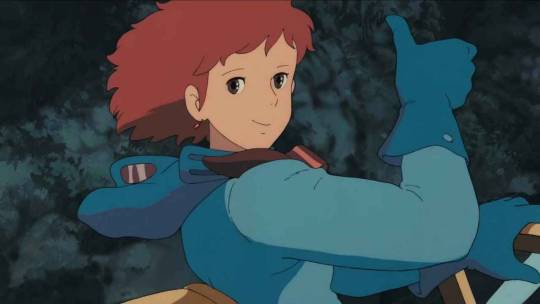
Unlike the above entry, I did struggle a little bit with picking a single Studio Ghibli film. Most media of the Ghibli catalogue have strong, well-written, unique, and interesting female leads so selecting just one seemed like quite the task.
However, I eventually settled on this particular film. In recent months, Princess Nausicaä has become my absolute favorite Ghibli protagonist and I'm absolutely enchanted by the world she lives in.
Set in a post-apocalyptic world overun by giant insects and under threat of a toxic forest and its poisoness spores, Nausicaä must try to protect the Valley of the Wind from invaders as she also tries to understand the science behind the toxic forest and attempts to bridge the gap between the insects and the humans.
For those who have never seen the film, I think Nausicaä's personality can best be described as being similar to OT Luke Skywalker. Both are caring, compassionate, and gentle souls who are able to see the best in nearly anyone or anything. She's an absolutely enthralling protagonist and after rewatching the film again for the first time in well over a decade she has easily become one of my all time favorite protagonists.
Whenever I see people talk about Ghibli films, they rarely mention this one, and when they do mention it, it's often in passing. In my opinion it's a must watch.
⚠️ This movie contains some blood, and the folks who either don't like insects or who have entomophobia may not appreciate the giant bugs running about throughout the movie. (Although most insects do not directly relate to real life bugs, and are fantasy creatures).
A Silent Voice

A Silent Voice is an animated movie adaptation of a manga of the same name. While I've never had the pleasure to read the manga, the movie is phenomenal. It covers topics such a bullying, living in the world with a disability, the desire for atonement, social anxiety, and depression in a well thought out manner that ties itself together through the progression of the relationship between its two leads, Shoya and Shouko. It's also beautifully animated. Although very popular among anime viewers, I've noticed that it's often overlooked by people who watch little to no anime. So I suppose this is me urging non-anime viewers to give this film a chance.
⚠️ As mentioned above, the movie deals with bullying, anxiety, and depression (with this last one including suicidal thoughts and behaviour). If discussion of those topics are triggering to you, than you may want to proceed with caution or skip this movie all together.
In This Corner of The World

Another manga adaptation, this one taking place during WWII-era Japan. In This Corner of The World follows the life of a civilian Japanese woman, Suzu Urano, as she navigates simply living and her new marriage as the wartime invades nearly all aspects of everyday life. I think this movie is a good representation of what it must be like to be living as civilian in a country at war where the fight is sometimes fought on one's own soil. It was also an interesting look into pre-50s Japanese culture in my opinion. It's also beautifully animated featuring an art style I don't see often.
Despite it being well known among anime fans, I never really see it be brought up, even among said anime fans themselves.
Side note: I've seen many WWII dramas centering around civilians but they've almost always been about American or UK civilians. This was the first movie I'd seen that features the perspective of a Japanese civilain.
⚠️ Features the death of a child and limb loss. There's also a disturbing scene featuring a victim of one of the atomic bombs near the end.
Wolf Children: Ame and Yuki

This film follows Hana, a Japan-native woman who fell in love with a magical shape-shifting wolf-man, and her trials with raising their children, who can also magically shape-shift into wolves, on her own. It's a very heartfelt movie about a mother's love and the struggles of doing right by your children when you have limited resources to actively guide and care for them. All the characters feel unique and alive in my opinion. Also, the animation is so good that my sister and I initially mistook it for a Ghibli film.
Again, like the previous two anime entries, I don't see it ever brought up outside of anime circles.
⚠️ There's some child endangerment present in the film, although none of it is the fault of Hana as far as I can remember.
Roman Holiday
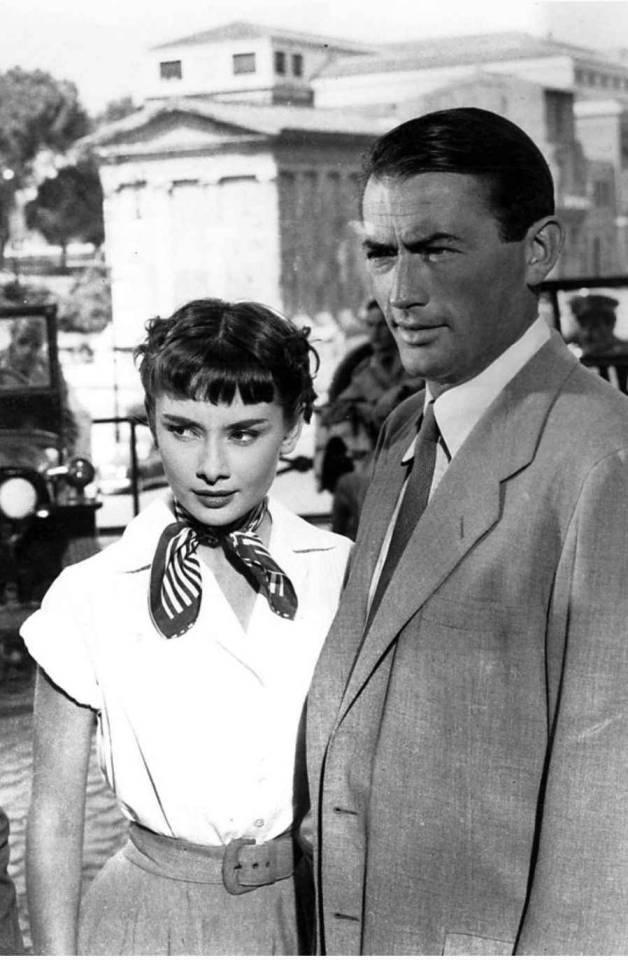
Roman Holiday is about the fictional Princess Ann (played by Audrey Hepburn), who while on a whirlwind tour of Europe, finally reaches her breaking point over having her entire life be one big schedule and all her words and actions being rehearsed. In the spur of the moment, she runs away in hopes of experiencing what life is like for other women. Unfortunately, she was previously given a sedative, meaning she doesn't get too far before it takes effect. Fortunately, she is found by the kind reporter Joe Bradley (played by Gregory Peck). Believing her to be drunk and unable to get an address from her (because she has none) he ends up taking her home for safety's sake and allows her to sleep off her suppose drunken stupor. The next day, he realizes who she is, and decides to take her on a fun sight seeing trip across Rome in hopes of getting the big scoop. Along the way, they begin to fall for each other.
This is my favorite black and white, old romance film. I think the relationship between the main characters is absolutely beautiful and I have a lot of fun watching it.
⚠️ I'm not entirely sure what kind of warning this film would need. However, it was released in 1953, so values dissonance will probably be at play for many viewers to at least some extent. For example, early in the film Ann is given sedation drugs by her doctor for her behavior, something that is very unlikely to happen today. Also, Mr Bradley deciding to take Ann home to keep her safe rather than call the police or an ambulance is a very pre-90s decision in my opinion.
#hanna 2011#a simple favor#i am mother#lilo and stitch#nausicaä of the valley of the wind#a silent voice#in this corner of the world#wolf chilren ame and yuki#wolf children#roman holiday#black and white film#anime#disney#studio ghibli#movie recs#top 10
177 notes
·
View notes
Text
The Story Of The Abandoned Car Factory Pragovka
Prague is a city of postcard-perfect architecture: from immaculate works of Gothic beauty – like St. Vitus Cathedral and the 13th century Old New Synagogue in Josefov – to the statue-lined Charles Bridge, or the monumental neo-Renaissance building of the National Museum looking out across Wenceslas Square. It is not a city that most would associate with industrial decay, however Prague’s former palaces of industry are no less grand, even while history is in the process of burying them.

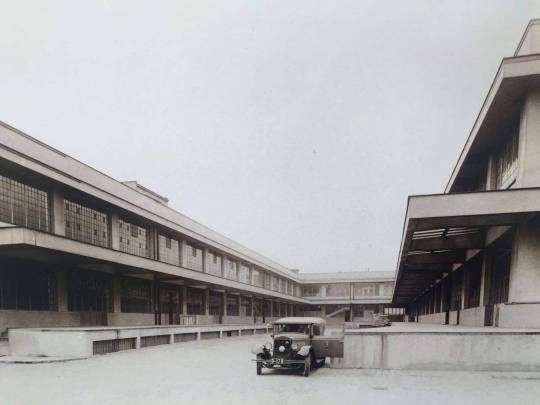
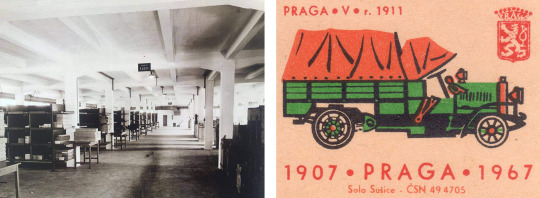
The Praga Car Factory Pragovka. | Photo via E-Factory.cz
The Praga Car Factory Pragovka on the city’s eastern edge was once the beating heart of the Czechoslovak manufacturing industry. It played a significant role in the city’s 20th century history, but it was here at the Prague’s darkest days was set into motion. In 1968 workers at Pragovka sent a letter to the Soviet Embassy requesting support in the fight against liberalisation. This letter, published in Pravda, would then be used as justification for the Warsaw Pact invasion of Czechoslovakia.
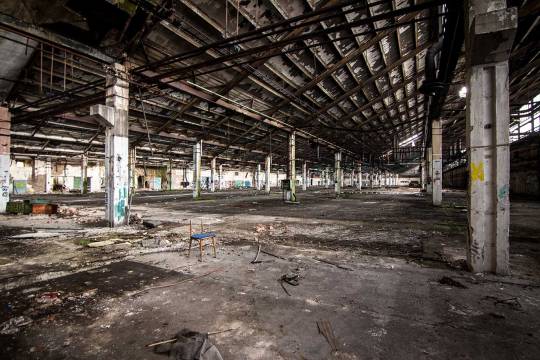
The Praga Car Factory today. | Photo Katka Havlíková
Pragovka is abandoned since the turn of the 21st century and is now a sprawling ruin, its extravagant factory halls succumbing slowly to time and nature. In 2017 I went to explore what was left of it. The Car Factory was founded in 1907 as a manufacturing site in the eastern suburbs of Prague, with just 30 employees. Two years later, its parent company adopted the name ‘Praga’ – the car brand used the Latin form of the city’s name in the hope of sounding more international. During WWI the Praga factory (then known as the First Czech-Moravian Machine Factory) supplied the Austro-Hungarian army; then after 1918 and the independence of Czechoslovakia, it began to focus more on passenger cars.

The main hall of the Pragovka factory in 2017. | Photo Katka Havlíková
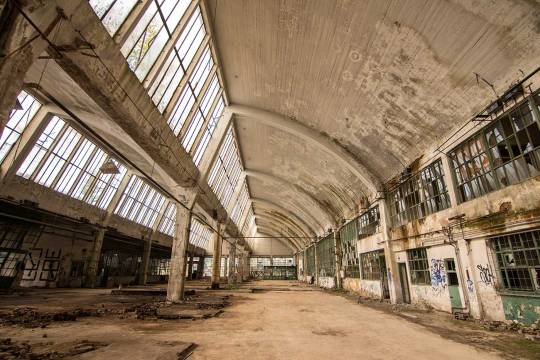
The large, angled windows allowed plenty of natural light to enter, reducing electricity costs. | Photo Katka Havlíková
In 1927 Praga was incorporated into the new ČKD (Českomoravská Kolben-Daněk) group, one of the largest engineering companies in Czechoslovakia. Among other vehicles (including tanks, locomotives, tractors, motorcycles and metro cars), ČKD produced cars under the Praga, Škoda and Tatra brands, and was famous for making the Tatra T3 tramcar – a design which would sell almost 14,000 units, and become an iconic sight on the streets of socialist cities from Sarajevo to Tashkent. Meanwhile as many as half of the taxis on Prague’s streets had rolled out of this factory.

Left: Cover of a 1962 sales brochure from Strojexport, featuring the Tatra T3 tramcar. Right: Vintage poster featuring the Tatra T77.
In recent years, the Pragovka complex has been recognised as a heritage site and some of its spaces have been developed into an arts district. There is a retro-themed ‘Pragovka Cafe,’ and the place hosts film screenings, concerts and festivals. Reportedly as many as a hundred local artists have studios now on the former factory grounds, while the large E-Factory building has been converted into a gallery space.
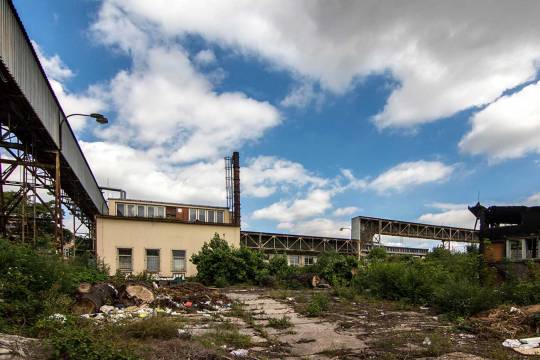
Some outer buildings still remain, linked by covered walkways. Other buildings have been bulldozed. | Photo Katka Havlíková
There’s talk of building apartments here too in future, a trendy new community rising up amidst the industrial decay. A large part of the complex remains off-limits for now though – and it was here that we entered. During the visit of Prague was fortunate enough to be offered a tour of its best ruins the local photographer Katka Havlíková.

Raised gas pipes above an overgrown courtyard. | Photo Katka Havlíková

The factory has been abandoned long enough for creepers and graffiti to cover many of its surfaces. | Photo Katka Havlíková

Katka picks a careful path through the debris-field, towards the first of the factory’s grand production halls. | Photo Katka Havlíková
She led us around the back of the factory where we scrambled up a slope of rubble to reach a promontory at the corner of the former yard. Ahead of us lay a sea of green. Thick vegetation hid the concrete courtyard, with only the occasional street light, rising like drowning hands from water, to suggest that anything unnatural lay beneath. The main buildings, those still standing, were just visible through the trees and so we cut a path down through the overgrown wreckage towards the old factory halls.
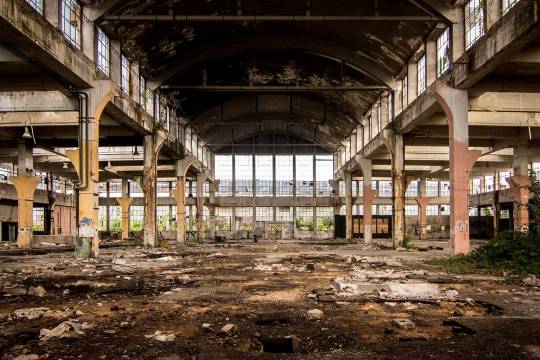
The largest of Pragovka’s manufacturing halls looks no less grand today with its full-height windows. | Photo Katka Havlíková
After poking around in a few of the outer buildings that rise now out of bushes and debris, we made it finally to the main manufacturing halls of Pragovka. It was strange to see a building this grand left to ruin. The complex was built back in a time when factories and power plants were temples of the people – places of pride, not merely function, their spaces defined with grand architectural flourishes. This main hall could have been a train station, not a car factory. Natural light illuminated the hall from floor-to-ceiling windows (much of their glass still intact), while pillars supported an arched ceiling high above.
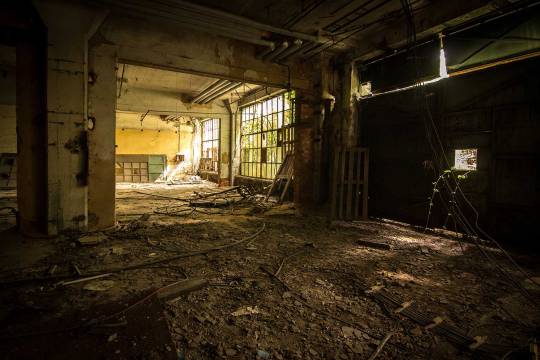
Nature creeps into Pragovka – vines find a way inside through broken window, letterboxes, or any other breach in the outer wall. | Photo Katka Havlíková
We didn’t see the new arts district at all – a fact indicative of just how large this complex was – but it was hard to imagine how any small business or community project could successfully take over a space like this. The factory halls were beautiful, but built on such a scale that maintenance and repairs would be an extraordinary burden, particularly after all these years of decline.
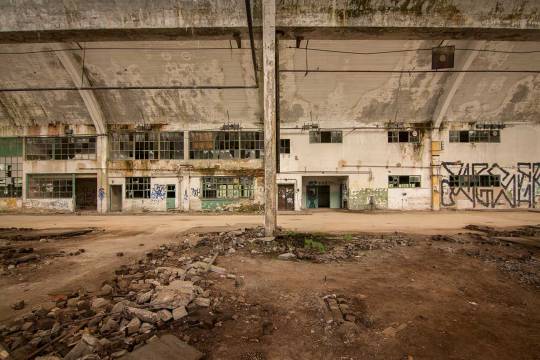
Two levels of offices lined the wall. | Photo Katka Havlíková

A staircase connects floors inside the main building. | Photo Katka Havlíková
The seeming inevitability of this factory’s ruin cast a melancholy mood over the few hours we spent wandering the halls of Pragovka. Right now, like this, with the warm sun slicing in sideways through the dirty glass windows, and the greenery of nature’s scouts – along with bursts of bright graffiti – lending fresh colour to the otherwise muted palette of pastel-painted walls and pillars: Pragovka might never look this good again.

Old ledgers amongst broken glass in the courtyard.| Photo Katka Havlíková
When Pragovka falls, much of its history will be buried with it; and perhaps for some, that might be for the best. Pragovka is remembered not only as the heart of the Czechoslovak manufacturing industry, but it is also a place where the communists made their stand – forever linking these buildings with a historic victory for the pro-Soviet movement. In 1968 the Soviet Union and its allies led an overnight invasion of Czechoslovakia – to suppress the Prague Spring, a growing liberalisation movement under First Secretary Alexander Dubček. Although history remembers the event as an act of totalitarian foreign aggression, that invasion was not, in fact, universally unwelcome.

A wall has collapsed to reveal the stairwell inside. | Photo Katka Havlíková
Numerous workers’ unions in Czechoslovakia supported Soviet intervention in their country, and one of the key triggers of the invasion was a letter of invitation, that was written here, at the Praga Car Factory. In 1971 the Czechoslovak journalist Josef Maxa authored A Year is Eight Months, which recounts the events of the Prague Spring and leading up to the invasion. “Moscow’s Pravda published a letter from ninety-nine workers in the Pragovka factory in Prague to the Soviet Embassy,” he wrote. “The letter denounced the Czechoslovakian enemies of socialism and of the Soviet Union.” That document was known as the “Letter of the Ninety-nine Praguers,” and it warned the Soviet Embassy how: “the manifestations of the democratisation of society in our republic threaten the building of socialism and in so doing, attack the blood-hardened friendship between the Czech and Soviet peoples” (as paraphrased by Martin Půlpán).
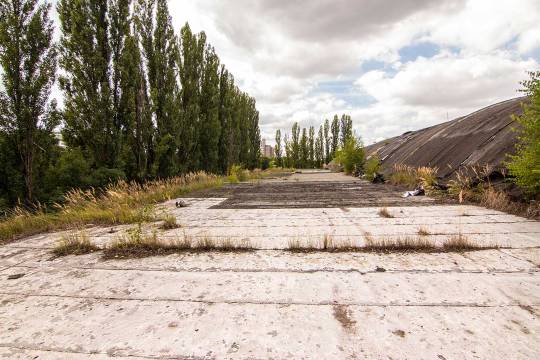
Rooftop above one of the manufacturing halls.| Photo Katka Havlíková
The letter claimed that all honest citizens of Czechoslovakia felt safer in the presence of Soviet and Warsaw Pact troops occupying their country. When Pravda printed the letter, on 30 July 1968, along with all ninety-nine signatures, the document would be used as justification for the swift invasion that followed in August. The incoming normalisation government that subsequently took charge of Czechoslovakia would valorise the authors of that letter – raising a memorial plaque at the main entrance to Pragovka, that read: “In the revolutionary tradition of this great workers’ nation, a letter with ninety-nine signatures was sent to the USSR in the critical year of 1968, requesting support and assistance in fighting anti-socialist forces.”

A bright and airy side room near the main factory floor. | Photo Katka Havlíková
Nowadays that plaque is long gone. The gates of Pragovka stand barred, and the halls where the letter was written are lost to a maze of rubble, weeds and graffiti. The factory’s decline today is an inevitability – it is a temple to a lost industry, a relic displaced from its time and no longer fit for purpose in the new industrial landscape of the Czech Republic.

The wall in a former office space. | Photo Katka Havlíková
Though Pragovka’s political history likely doesn’t help to endear these halls to the citizens of contemporary Prague – and it’s hard not to read some level of symbolism as this celebrated factory, once enshrined like a victorious battlefield in Czechoslovakia’s communist historiography, is slowly carved up, and crushed, by the oncoming future.
--
by Darmon Richter
[adapted with permission from an article at Ex Utopia]
22 notes
·
View notes
Text

The history of artisanship in Mexico runs deep. Long before Europeans set foot in Central America, pre-Hispanic cultures were weaving, carving and moulding materials into everyday objects. It was once a country of many nations – from the Mayans in the Yucatán to the Aztecs in the Central Plateau – each with distinctive cultures, as well as their own advanced style of architecture and artisanship.
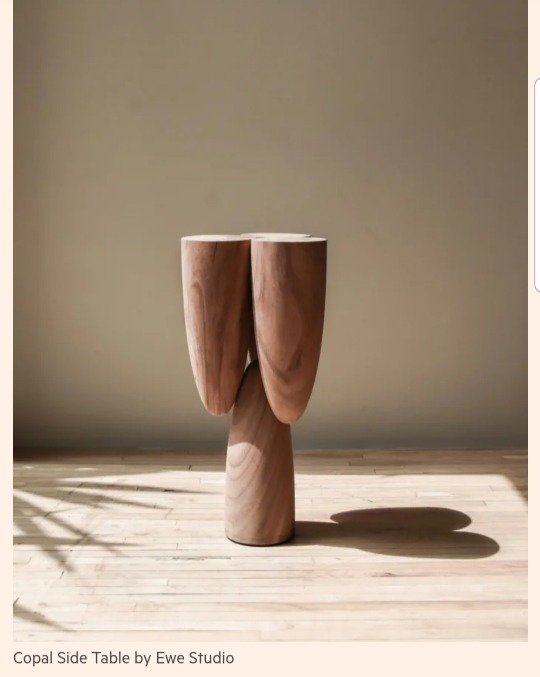
In recent years, Mexican designers have begun to look inward, acknowledging the wealth of talent and resources on their doorstep rather than from outside influences. Other creatives are joining them from overseas, flocking south in search of culture, skills and materials.
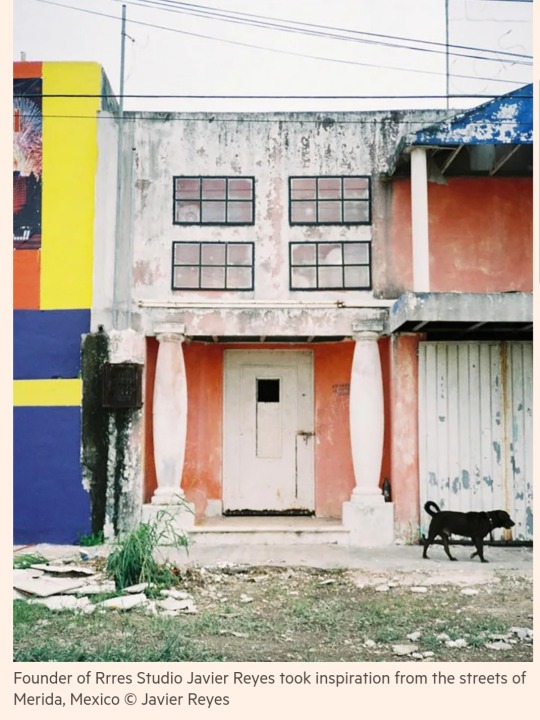
One such creative is French-born product and furniture designer Fabien Cappello, who, following a three-week holiday, uprooted his life in London (where he’d lived for eight years having studied at the RCA) to relocate to Mexico City, before moving west to Guadalajara. “I was just so struck by the culture,” he says of the life-changing experience. His work incorporates local resources and manufacturing. “There isn’t a city in the world with more metal workshops than Guadalajara,” he adds. “Repairing or making something specific to your needs in a very local way is a concept that is still relevant here.” His pieces incorporate traditional materials: from seats tightly woven in natural tule reed fibre to vintage chairs with geometric fabric. “Everything I wanted to develop in my design work is so present in Mexican materials. To understand more, I needed to participate.”
This focus on Mexican design heritage reflects a growing interest in its culture. Evidence of this can be seen in the success of chefs such as Enrique Olvera, who has opened a string of restaurants (including Cosme in New York City), casting a spotlight on what is arguably one of the world’s most historic, complex and creative cuisines. “There is more support for Mexico globally,” says Age Salajõe, a cofounder of Mexico City based Ewe design studio. This coincides with the general shift towards the artisanal, which has given Mexican designers a platform, while instilling a sense of pride and confidence in their cultural values. “We stopped caring about working on a stereotyped expression of our culture, and stopped developing design based on the expectation of what Mexico is for others,” Esrawe adds.
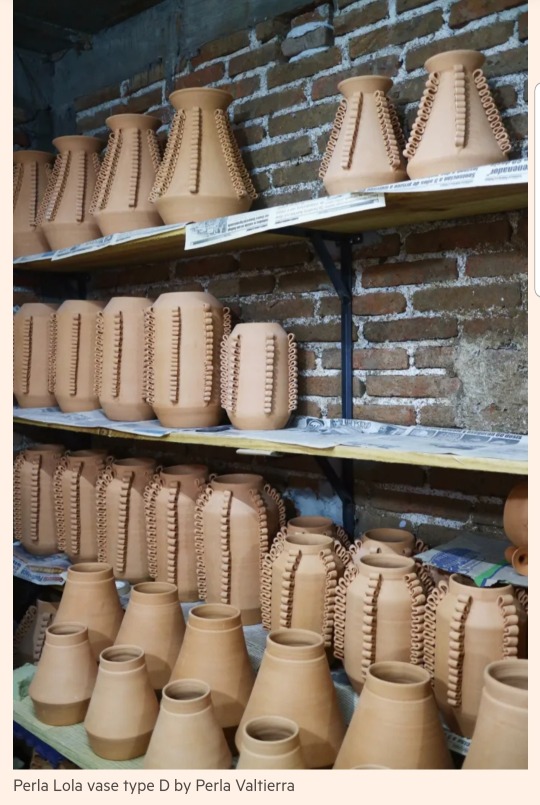
For many designers, the answer to the country’s design future lies in the past – and the skills passed down through generations, often in small rural communities. Many such skills risk being lost forever without timely intervention. Ceramicist Perla Valtierra turned her attention from industrial design to ceramics after participating in a craft and design program with a community in Zacatecas.
“I became aware of the possibilities we have in Mexico and realised how many people are out there making things across the country,” she says. She now produces ceramics with master craftsman Don Jes��s Torres (whose skills were passed down to him from his father). Their pieces, hand-turned on the wheel, include tea cups and side plates with frilled rims and vases with rivet detailing. “The process is completely collaborative. We’re learning from each other,” says Valtierra, who sees a value not only in preserving these techniques but in creating a sustainable supply chain.
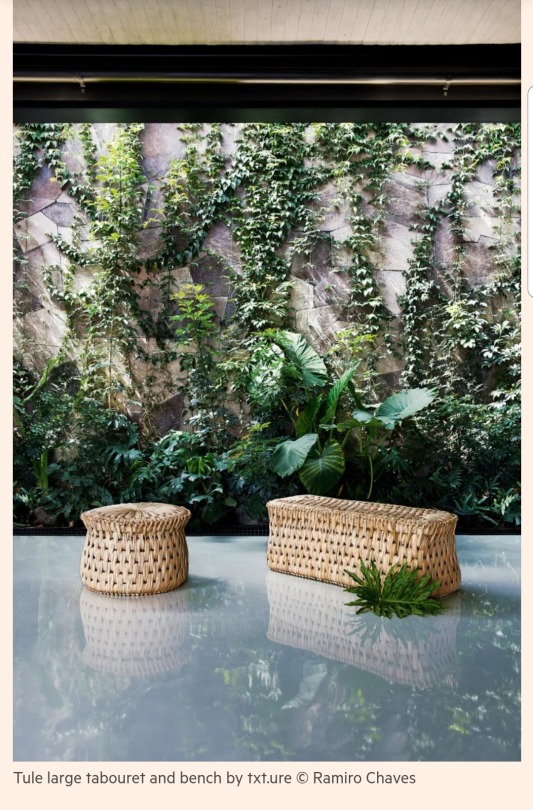
Establishing a sustainable infrastructure where artisans are empowered to work independently in their own social and cultural environments – while enabling them to thrive – is the impetus behind txt.ure, founded by Regina Pozo. The project aims to revive techniques and reinterpret objects, as well as create visibility and channels for distribution. Its signature piece is a tabouret stool woven from tule using an ancient weaving pattern. What makes it so special is that it embodies the idea of reinterpreting something old into the modern – in this instance that an item harking back to the Aztecs is just as relevant and desirable today.
Ewe Studio also fuses artisan heritage with new mediums, and collaborating with master craftsmen allows its designers to work with people they’ve long admired. “Sometimes they challenge us, sometimes we challenge them – it creates a mutual learning process,” says Esrawe. The result of this approach includes a Tikal green marble table hand-carved by stonemasons and a sculpture-like altar marble table inspired by religious rituals and ceremonies, bringing pre-Hispanic skills, materials and ideas into the 21st century.
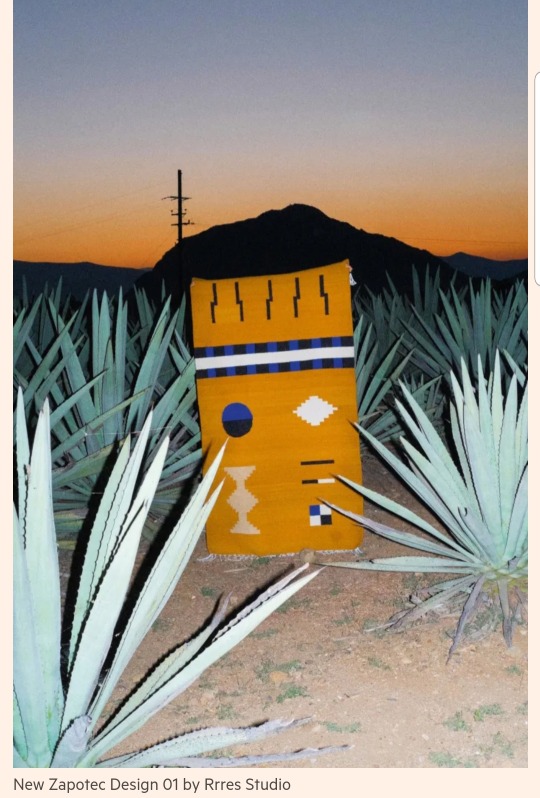
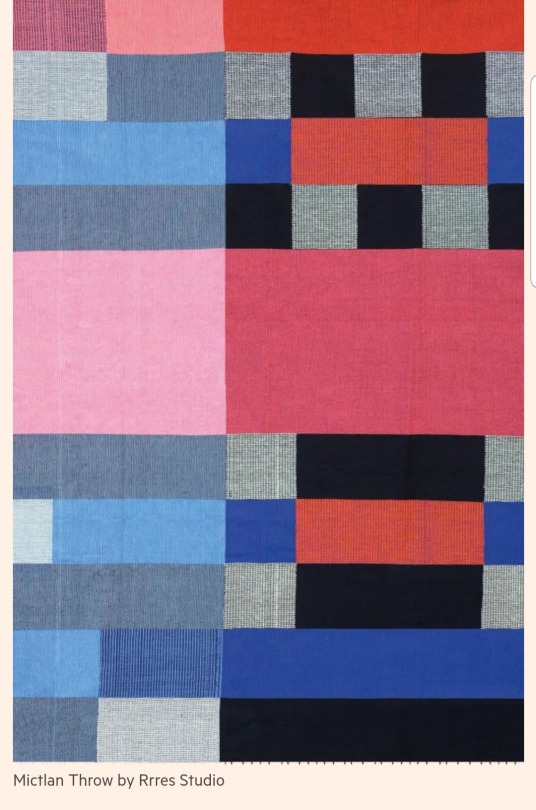
Collaboration is also key for Dominican-born designer Javier Reyes, founder of Rrres, which he has established in Oaxaca, Mexico. “Having something handmade is luxury,” he says of the renewed interest in heritage design and craftsmanship. He has sought out under-the-radar artisans, often without access to the resources needed to showcase their skills. His bright, geometric, hand-dyed rugs are made by Zapotec weavers while tall playful palm sculptures are crafted using a traditional weaving technique from Guerrero. It’s a collective effort.

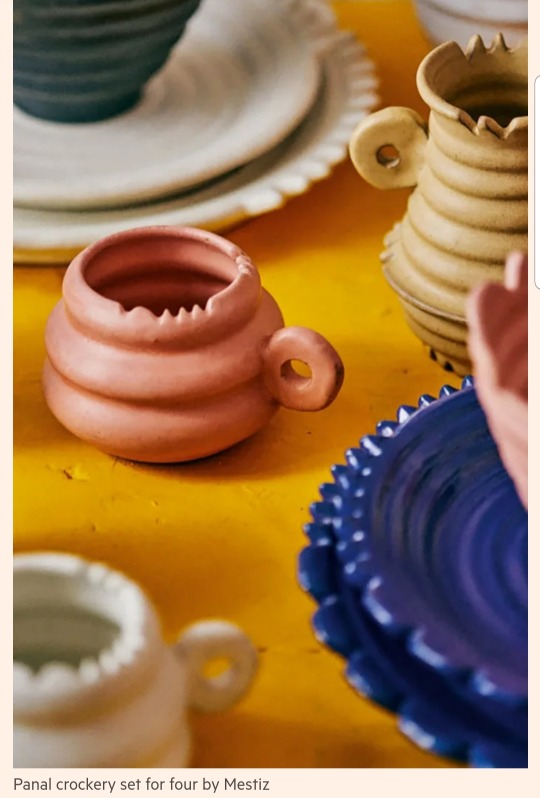
These distinctive designs embody the region in Mexico in which they were made. Even if you haven’t visited the country, they transport you there. “One of the things about craft-design is that you can tell a story of place,” agrees designer Daniel Valero of Mestiz. Born in Saltillo in the north of the country, Valero began collaborating with artisans to experiment with the traditional sarape weaving technique to create new textiles in 2014. He went full-time with his brand in 2018 and now works with makers across the country from Guanajuato to Bajio, creating ringed pottery in ultramarine, light pink chairs woven from palms by nomadic craftsmen and colour-blocked freeform wool rugs – pieces with a deep connection to the regions in which they originated. “I’m trying to continue the evolution of craft where it began,” Valero explains. “Someone has to do it, because everything that doesn’t evolve dies.”
As this new wave of creators shine a light on Mexico’s heritage, reviving techniques on the brink of extinction, the rest of the world has begun to take note – and the colourful, organic forms of Mexican design are set to be a big trend for 2021 and beyond. “Mexico has become a reference,” Esrawe concludes. “And as designers we’ve begun to look at who we are as a culture with pride.”
#mexico#indigenous#aztec#zapotec#france#london#europe#dominican republic#latin america#🇲🇽#new york#usa#united states
14 notes
·
View notes